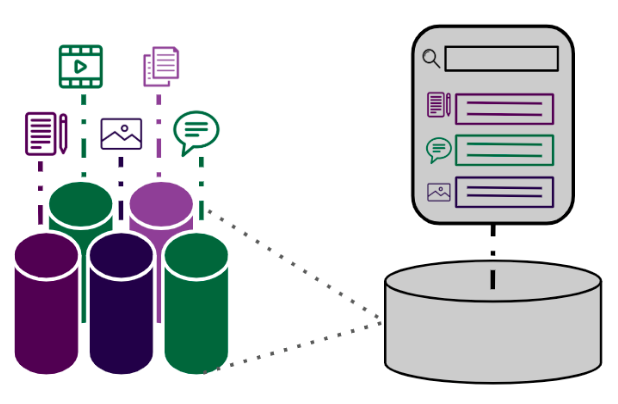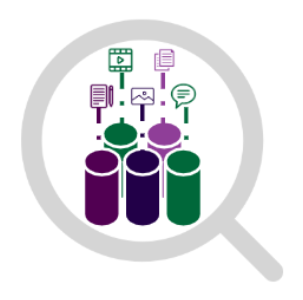Organizations are producing exponentially more content than ever before. In most businesses today, every employee is a content creator which has led to multiple, uncoordinated content management systems (CMS). Siloed systems cause content management issues such as duplication of content, inconsistent messaging, access risks, and version control. This leads to loss of productivity, risk of inaccurate content, and low user satisfaction. Fortunately, there are ways to break down silos without incurring serious costs or adopting burdensome processes.
Causes: Why is Content Siloed?
Organizations introduce new content management systems as a quick fix to their problems when their existing systems can’t support new functionality. They think that it’s easier to add a new technology rather than confront the root issues. There are a variety of use cases that prompt companies to add a CMS:
- Expanding Content Types: Legacy systems do not have the capability to accommodate new types of content. Enter new platforms to manage data, videos, and social media.
- Collaboration: Companies are seeing the benefit of collaborating on documents in real-time rather than exchanging edits over email. Enter new collaboration tool.
- Permissions Control: Not everyone at a company should have access to particularly sensitive documents. Enter new legal document management system.
- New Ways to Present Content: People are increasingly consuming content on their phones and watches, not just through print and the web. Enter new a new CMS to publish to each channel.
Problems: Implications of Content Silos
Disconnected, siloed systems make it much more difficult to get value from your content. There are a number of implications to content silos, including:
- Duplication: Companies want to be able to reuse their content, but they can’t think of how to do that if there are multiple systems. A common quick fix for this is creating copies of content in each CMS. If one of these pieces of content needs to be updated or removed, there’s no way to access every version across disconnected systems.
- Findability: Users have a hard time finding content when it is stored in multiple systems. Not only do they have to alter their search behavior per system, but they also spend extra time searching in each system separately.
- Lost Relationships: When content is managed in silos, organizations cannot capture relationships between content, like a blog sharing the same topic as a video or a legal document substantiating a claim in a deliverable. These relationships create important context that increases the usability of content.
Solutions: Breaking Down the Silos
There are ways to address content silos other than trying to force all of your content into a single traditional CMS. Content migration to a monolithic CMS is typically a lengthy and costly process, and still only fulfills a limited set of requirements. Fortunately, there are alternatives:
Introduce a Headless CMS: A Headless CMS takes a content-first approach to give you flexibility in the expanding ways that your organization will use its content. Going headless centralizes and normalizes the way that content is modeled across the enterprise, but its feasibility depends on reliance on existing systems. There is a short-term tradeoff of cost, time, and disruption, but in the long-term it reduces the risk of future silos and accommodates a wide set of requirements.
a content-first approach to give you flexibility in the expanding ways that your organization will use its content. Going headless centralizes and normalizes the way that content is modeled across the enterprise, but its feasibility depends on reliance on existing systems. There is a short-term tradeoff of cost, time, and disruption, but in the long-term it reduces the risk of future silos and accommodates a wide set of requirements.
 Develop a Metadata Hub: Without moving content from existing systems, organizations can aggregate metadata, or the descriptive information associated with content. This solution is beneficial if workflows and logic are highly embedded into existing systems and cannot be decoupled. The best way to implement this solution is through a graph database that contextualizes content by pulling the associated metadata from siloed systems. This is foundational for creating a streamlined search experience and even allows organizations to capture the relationships between content required for recommendation engines.
Develop a Metadata Hub: Without moving content from existing systems, organizations can aggregate metadata, or the descriptive information associated with content. This solution is beneficial if workflows and logic are highly embedded into existing systems and cannot be decoupled. The best way to implement this solution is through a graph database that contextualizes content by pulling the associated metadata from siloed systems. This is foundational for creating a streamlined search experience and even allows organizations to capture the relationships between content required for recommendation engines.
 Implement Enterprise Search: Introducing an enterprise-wide search layer on content silos is an effective way to uncover and address issues with duplication and findability. This solution allows organizations to maintain their current systems, while aggregating the content inside of them. Enterprise Search is less disruptive than the above solutions because it does not require migration or database management, but it does not allow users to manage content across systems. However, creating a streamlined and intuitive search experience can be exactly what an organization needs to increase productivity and reveal inconsistencies.
Implement Enterprise Search: Introducing an enterprise-wide search layer on content silos is an effective way to uncover and address issues with duplication and findability. This solution allows organizations to maintain their current systems, while aggregating the content inside of them. Enterprise Search is less disruptive than the above solutions because it does not require migration or database management, but it does not allow users to manage content across systems. However, creating a streamlined and intuitive search experience can be exactly what an organization needs to increase productivity and reveal inconsistencies.
 Design a Business Taxonomy: A Business Taxonomy will standardize the way that content is described and organized across siloed systems. This enables users to have a consistent experience in different CMS and is foundational for improving findability and productivity. This does not address challenges with duplicative content or lost relationships, but it significantly lowers the barriers that organizations face with content management. Implementing a Business Taxonomy is also one of the best ways to see improvements quickly.
Design a Business Taxonomy: A Business Taxonomy will standardize the way that content is described and organized across siloed systems. This enables users to have a consistent experience in different CMS and is foundational for improving findability and productivity. This does not address challenges with duplicative content or lost relationships, but it significantly lowers the barriers that organizations face with content management. Implementing a Business Taxonomy is also one of the best ways to see improvements quickly.
Breaking down content silos streamlines the ways that users access content to increase productivity and reduce the risk of having duplicate content across systems. Introducing a solution to address your organization’s content silos immediately adds value to your content and is critical to anticipate future uses. Not sure how to get started? We’re here to help! Reach out to info@enterprise-knowledge.com.
